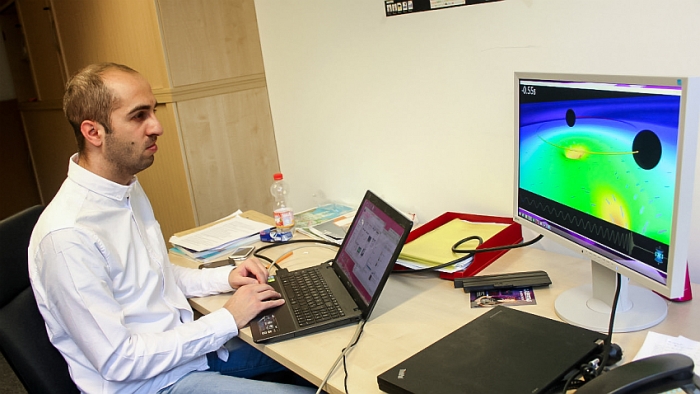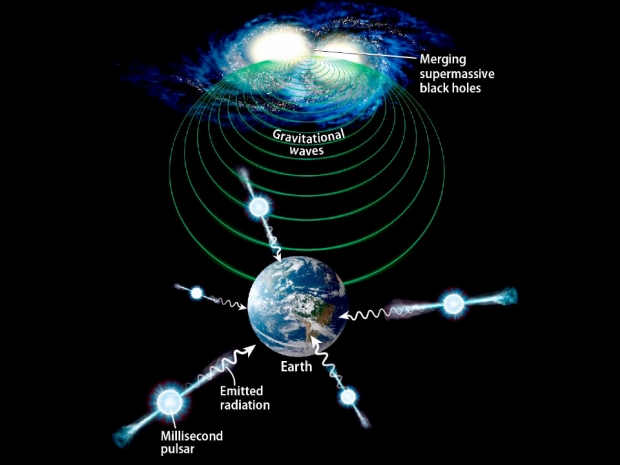Since August 2002, scientists have been operating a large-scale physics experiment called the Laser Interferometer Gravitational-Wave Observatory, or “LIGO, to detect gravitational waves, or ripples in the curvature of space-time which propagate as waves, travelling outward from a source. Gravitational waves carry information about their origins and about the nature of gravity that cannot otherwise be obtained, according to LIGO scientists.
Over the past thirteen years, the twin LIGO detectors operating in Livingston, Louisiana and Handford, Washington, have detected nothing. Both locations run a pair of concrete pipes nearly two and a half miles long and twelve feet tall in search of gravitational waves. Until last fall, they have found nothing.
On the dawn of September 14, 2015, Marco Drago was working in his office at the Max Planck Institute for Gravitational Physics in Hanover, Germany when his automated computer pipeline sent him alert. It was a message telling him that the twin LIGO detectors in Louisiana and Washington had registered an “event.”
The event was the result of two ~30 solar mass black holes merging together after coalescing around each other about 1.3 billion light-years away from Earth. In fact, the registered signal was so strong that Drago didn’t believe it was real. “No one was expecting something so huge,” he said. “So I was assuming that it was an injection.”
And rightfully so. Gravitational waves stretch space-time by such a very miniscule amount that LIGO physicists have developed mechanical systems to shake them up and “inject” a fake signal. This is part of the testing procedure at both laboratories and are meant to keep researchers on their toes and not falling asleep in the labs.
The Sound of Two Black Holes Colliding – California Institute of Technology LIGO Lab
The concept of gravitational waves was originally part of Einstein’s Theory of General Relativity, which he published 100 years ago in 1915. During that time period, however, he lacked the technology to test his theory, leaving theoretical physicists with only a paper trail framework without any instrumentation for recording and tracking down the waves themselves. Roughly a century later, we finally have the first recording of a massive gravitational deep space event – and it sounds like nothing more than a bird’s chirp.
The Livingston, Louisiana station heard the chirp 7 milliseconds before the Hanford, Washington station did. Scientists have inferred that the signal must have then originated from Southern Hemisphere skies.
An hour after receiving the alert, Drago asked if anybody within LIGO was aware of anything that could be an injection. A few days later, collaboration leaders verified the signal and sent out a follow up memo to the entire LIGO team saying that the signal probably was not an injection.
“I’m going to call up my family and say, ‘You know, I was the first to see this,’” said Drago in the aftermath of the discovery.
Marco Drago is a 33-year old postdoctoral fellow from Padua, Italy in charge of overseeing one of four data “pipelines” at LIGO that sift through raw data looking for potentially interesting signals. In 2015, he published a paper titled, “Low Latency transient search of Gravitational Waves for the Advanced Detectors.”
Marco Drago saw the first gravitational wave on September 14, 2015 (via Science Magazine)
It was originally difficult for LIGO leaders to keep a lid on the news. “It was a challenge,” said Gabriela González, a physicist at Louisiana State University, Baton Rouge, and spokesperson for the LIGO scientific collaboration. “But from the beginning we explained [to the collaboration] the need for confidentiality” while the analysis was ongoing. “You cannot make an announcement and then say, ‘Oops! Sorry, we were wrong!’” Gonzales added, “It’s been a lot of pressure, answering to people, not answering to people. But we never lied.”
“We’re saying that we made a measurement that is about a thousandth the diameter of a proton, that tells us about two black holes that merged over a billion years ago,” said David Reitze, the executive director of CalTech's LIGO Laboratory. “That is a pretty extraordinary claim and it needs extraordinary evidence.”
Four days later on September 18, 2015, the LIGO Laboratory started new deep space observations using “Advanced LIGO” detectors at a sensitivity roughly four times greater than Initial LIGO. These detectors operate at much greater sensitivity for large systems emitting peak radiation at lower audible frequencies. The laboratory intends to further improve detector sensitivity in 2019 until it reaches full sensitivity by 2021.
The news from September 14, 2015 was finally made available to the public on February 11, 2016. The full news release can be found here.
Below is a simulation by the Simulating eXtreme Spacetimes (SXS) Project on what the merger of two black holes might look like in deep space:
Two Black Holes Merge Into One – Simulating eXtreme Spacetimes (SXS) Project


